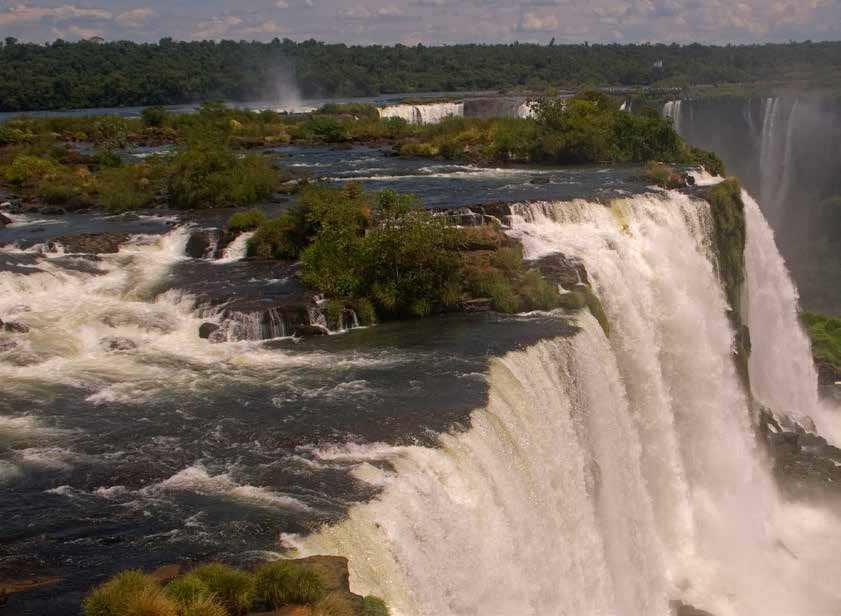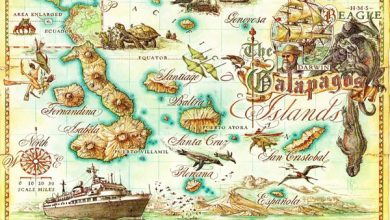Iguazu Falls History.

Iguazu Falls, discovered in 1541 by Spanish explorer Álvar Núñez Cabeza de Vaca, boasts a rich history and awe-inspiring beauty. The falls are located on the border between Argentina and Brazil.
Iguazu Falls, one of the world’s largest and most stunning waterfall systems, draws millions of visitors yearly. The name “Iguazu” originates from the Guarani words “y” (water) and “ûasú” (big). This natural wonder comprises 275 individual drops, with the most notable being the Devil’s Throat.
The surrounding Iguazu National Park, a UNESCO World Heritage site, preserves diverse ecosystems and wildlife. Indigenous legends tell tales of the falls’ creation, adding a mystical aura. The falls’ breathtaking views and rich history make it a must-visit destination.

Credit: iguazufalls.com
Ancient Origins
Iguazu Falls, known for its breathtaking beauty, has a rich history. The falls have mesmerized people for centuries. Let’s explore the ancient origins of this natural wonder.
Early Inhabitants
Long before European explorers arrived, indigenous tribes lived near Iguazu Falls. The Guarani people were one of the most notable tribes. They believed the falls were sacred. They used the surrounding forests for hunting and gathering. Their culture and traditions were deeply connected to the land.
Other tribes also inhabited the area, each with their unique customs. They lived in harmony with nature. They respected the powerful waters of Iguazu Falls. The falls provided them with fresh water and fish. The tribes built their lives around the falls, ensuring they thrived.
Mythical Legends
Iguazu Falls is rich with mythical legends. One of the most famous legends involves a serpent god named M’Boi. According to the Guarani myth, M’Boi demanded a maiden as a sacrifice. A brave warrior named Tarobá fell in love with the maiden, Naipí. They tried to escape the serpent god in a canoe.
Furious, M’Boi created the waterfalls to trap them. The legend says Naipí turned into a rock at the bottom of the falls. Tarobá became a palm tree at the top, forever separated. This story adds a mystical charm to Iguazu Falls.
Other legends also exist, each adding to the falls’ allure. These stories have been passed down through generations. They keep the magic and mystery of Iguazu Falls alive.

Credit: exploringtheearth.com
European Discovery
The European Discovery of Iguazu Falls is a fascinating chapter in its history. This discovery marked the beginning of its global recognition. The falls, nestled between Argentina and Brazil, were unknown to Europeans for centuries.
First Expeditions
The first European to set eyes on Iguazu Falls was the Spanish explorer Álvar Núñez Cabeza de Vaca. He stumbled upon the falls in 1541 during his expedition. Cabeza de Vaca was seeking a route to the interior of South America.
As he journeyed through the dense forest, he heard the thunderous sound of falling water. Curiosity drove him closer until he finally saw the breathtaking cascades. His discovery was monumental, as it introduced the world to one of nature’s wonders.
Historical Accounts
Historical accounts of Iguazu Falls began with Cabeza de Vaca’s reports. He described the falls in his chronicles, capturing the awe and majesty of the scene. His writings provided Europe with its first glimpse of the stunning waterfalls.
Later explorers and missionaries also documented their experiences. Their accounts added to the growing knowledge of this natural wonder. These early descriptions often highlighted the sheer power and beauty of the falls.
The European discovery of Iguazu Falls paved the way for further exploration. It also sparked interest in the region’s rich biodiversity and indigenous cultures.
| Explorer | Year of Discovery | Contribution |
|---|---|---|
| Álvar Núñez Cabeza de Vaca | 1541 | First European to see Iguazu Falls |
The legacy of these early explorers lives on. Today, Iguazu Falls is a world-renowned destination, attracting millions of visitors.
Modern Development
The modern development of Iguazu Falls has been a story of growth and preservation. This natural wonder has evolved into a significant tourist attraction. Efforts have been made to protect its unique ecosystem. These developments have shaped the falls into what they are today.
Tourism Growth
The establishment of national parks in the 1930s marked a turning point. Iguazu Falls became a hotspot for tourists worldwide. Improved infrastructure made it easier to access the falls.
- Roads and trails were built for better accessibility.
- Viewing platforms offered stunning vistas of the falls.
- Hotels and lodges catered to the growing number of visitors.
Tourism has brought economic benefits to the region. Local communities thrive on the influx of visitors. The beauty of the falls continues to draw people from all over the world.
Conservation Efforts
Conservation efforts have been crucial in preserving Iguazu Falls. The area is a UNESCO World Heritage site. This status helps protect the falls and its surrounding ecosystem.
| Year | Conservation Milestone |
|---|---|
| 1934 | Iguazu National Park established in Argentina |
| 1939 | Iguaçu National Park established in Brazil |
| 1984 | UNESCO World Heritage status awarded |
Efforts include:
- Habitat restoration to support wildlife.
- Anti-poaching measures to protect endangered species.
- Sustainable tourism practices to minimize environmental impact.
These actions ensure Iguazu Falls remains a natural treasure. Future generations will continue to enjoy its majestic beauty.

Credit: revista.drclas.harvard.edu
Cultural Impact
Iguazu Falls, a natural wonder, holds significant cultural importance. The falls have influenced various aspects of human life. This includes arts, traditions, and local customs.
In Popular Culture
Iguazu Falls have appeared in many films and TV shows. Famous movies like “Indiana Jones and the Kingdom of the Crystal Skull” feature the falls. The natural beauty captivates audiences worldwide.
Documentaries often highlight the falls’ majesty. They showcase its immense power and scenic beauty. Artists also draw inspiration from Iguazu Falls. They create paintings, photos, and even music based on this wonder.
Local Traditions
The local Guarani people hold Iguazu Falls sacred. They believe the falls have spiritual significance. Legends say a serpent god created the falls. This deity’s story is passed down through generations.
Festivals and rituals often occur near the falls. These events celebrate the natural beauty and spiritual essence. Locals also perform traditional dances and songs. These customs honor the falls and their cultural heritage.
Frequently Asked Questions
When Was Iguazu Falls Discovered?
Iguazu Falls was discovered in 1541 by Spanish explorer Álvar Núñez Cabeza de Vaca.
Who Named Iguazu Falls?
The name “Iguazu” comes from the Guarani words “y” (water) and “ûasú” (big).
How Were Iguazu Falls Formed?
Iguazu Falls were formed by volcanic activity and shifting tectonic plates millions of years ago.
Why Is Iguazu Falls Significant?
Iguazu Falls is a UNESCO World Heritage site, known for its stunning beauty and ecological importance.
Conclusion
Iguazu Falls has a rich history that captivates visitors. Its beauty and cultural significance make it a must-see destination. Exploring its past enhances appreciation for this natural wonder. Plan your visit to Iguazu Falls to experience its historical and natural magnificence firsthand.
Discover the stories that make it truly special.



